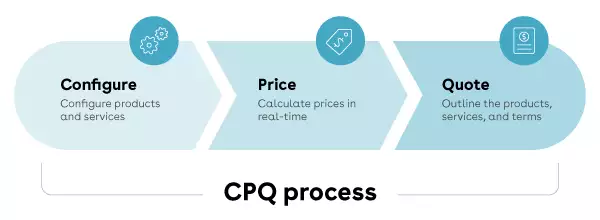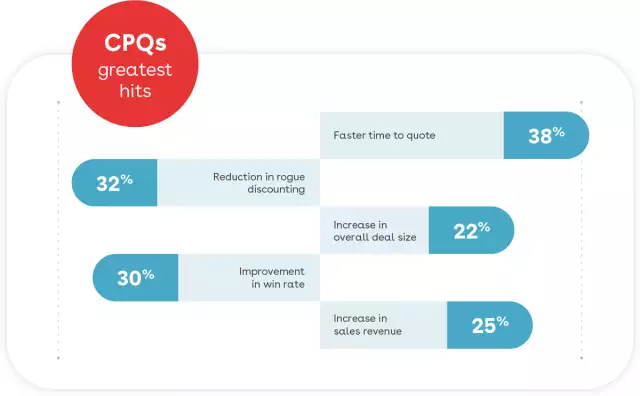
What is CPQ?

What is CPQ?
Configure, price, quote (CPQ) software is a tool designed to empower sales, partners, and customers to configure complex products and offerings with efficiency and accuracy. CPQ allows organizations to provide personalized prices and quotes for each customer using codified product and pricing information. This expedited process gives sales teams a chance to boost their win rates and create a better buying experience for their customers.
For most complex quote configurations, CPQ boosts effectiveness by giving sales the power to create the best quotes possible with accuracy and speed. CPQ software puts everything they need at their fingertips by aligning your revenue lifecycle from stage one. Complex product, pricing, and business rules are centralized and automated for real-time collaboration. Sales can maintain one price book, discounting structure, and quoting process across all channels.

How does CPQ work?
CPQ allows you to automate the entire revenue lifecycle by enforcing processes that mimic the actions of your best sales reps, driving faster and more accurate quotes at the optimal price. A better quoting process allows you to establish consistency across your business. Pre-configured guardrails ensure teams only sell using the latest approved pricing and discounting rules. These guardrails allow approvals to move along quickly without delaying your deals.
For organizations selling complex offerings, CPQ helps automate the processes required to sell these solutions. CPQ automation enables you to increase sales and improve your margins—creating a more efficient and profitable sales process.
Processes that can be automated by CPQ include:
- Ensuring sales reps use the correct product configurations with guided selling tools
- Determining optimal pricing for each component, including contracted prices
- Obtaining required approvals
- Finding upsell or cross-sell opportunities
- Providing an offer for the customer in hours rather than days, with a higher probability of closing the deal
Core CPQ functionality
CPQ identifies the ideal combination of products and services for each customer. The three core areas of CPQ each accomplish a different goal in the proposal and quoting process.
Configure
Within a configuration engine, CPQ solutions give you:
- Rule-based configurations
- Guided selling and deal scoring
- Nested bundles
A nested bundle lets users select from a subset of options within a single product option. - Product search catalog
- Cross-sell and upsell insights
Price
The pricing function within the CPQ tool contains:
- Discounting guardrails
- Simplified solution selling
Assign pricing rules at the line level, allowing you to combine one-time, subscription, usage-based, and more to enable selling subscriptions, services, and products on the same quote. - Promotion management
- Automated subscription management
Quote
To generate quotes, a CPQ tool provides:
- Quote collaboration capabilities
- Approval workflows
Control margin erosion or rogue product discounting by creating advanced approval features based on criteria that your organization is trying to manage - Quote templates and generation
Why is CPQ used?
The different capabilities of CPQ tools are clear, but what leads a company to bring this software into their business? You can take control of your entire revenue lifecycle with the integration capabilities of a modern CPQ tool. Organizations use CPQ for process optimization, including:
- Guided selling: Leverage the sales processes of your top sellers to increase win rates across all sellers.
- Standardized pricing: Eliminate rogue discounting and offer customers prices that are more likely to be accepted.
- Simplify selling of complex products: Codified, rules-based configuration simplifies the selling of complex products while offering insights into optional features and services.
- Quote collaboration: Collaborate on quote configuration in parallel with team members, expediting quote delivery.
- Approval management: Control margin erosion or rogue discounting by creating advanced approval triggers.
- Proposal generation: Create stunning proposal templates using Microsoft Word, without using technical resources or involving the programming team.
- Proposal tracking: Keep tabs on proposal emails to know when they’re opened.
- Contract integration and eSignature: Quickly generate a contract that can be managed and signed to complete the revenue lifecycle.
What are the benefits of CPQ?
CPQ software allows you to improve selling efficiencies by automating a large part of the revenue lifecycle—improving win rates and driving higher margins. With CPQ, you can provide faster, more accurate quotes to prospects. Not to mention, you can create a better buying experience for both the buyer and the seller, regardless of the selling channel.
Some overarching benefits of a CPQ tool include:
- Guided selling and deal scoring to increase win rates
- Improved accuracy of selling items using codified, rules-based configurations—regardless of product complexity
- Quotes delivered at unprecedented speeds
- Improved margins and win rates using robust pricing and promotions set up for contracted pricing to promote a better user experience
- Faster generation of quotes and proposals with cross-team collaboration, expediting the quote without compromising on quality
- Increased deal sizes with cross-sell and upsell insights, including full contract visibility
- Reduced SKU proliferation, allowing a single item to be sold as an item or as a subscription—reducing the need to create multiple SKUs for different product types
What’s the main advantage of CPQ?
Precision in Every Quote:
CPQ ensures spot-on quotes, eliminating errors and reflecting customer needs accurately. Smart pricing, real-time data, and configurations transform sales reps into trusted advisors, closing deals confidently.
Streamlined Sales Powerhouse:
CPQ automates complex processes, slashing quote generation time from hours to minutes. Automated workflows, approvals, and dynamic updates empower reps to build relationships and drive revenue swiftly. Agility and efficiency redefine your competitive edge.

Benefits by team
- Sales: CPQ software allows sales teams and leaders to accelerate deal cycles, increase win rates, and provide a better buying experience for customers. With automation, productivity and accuracy can increase dramatically, leaving more time to close deals. Proposals can be quickly guided through an accelerated deal cycle, considering best practices from top sellers in the company.
- Operations: CPQ can automate selling processes that improve the sales cycle while preventing rogue discounting and faulty configurations. With these guardrails, operations can increase efficiency and margins by dramatically shortening quote delivery times, minimizing rogue discounting, and incorporating company policies across the entire revenue lifecycle.
- Marketing: CPQ makes it easier for B2B customers to buy through self-service portals that offer guided selling and pricing optimization. Marketing account managers can take advantage of the upsell and cross-sell suggestions from CPQ, streamlining the buying journey and garnering higher customer loyalty.
Benefits to the customer
Did you know that up to 50% of sales wins go to the vendor that responds first? Increased quote accuracy reduces the back-and-forth between sales and customers, so customers receive their quotes faster. A consistent customer experience can also lead to higher retention rates, not to mention more cross-sell and upsell opportunities.
Does my organization need a CPQ tool?
Ask yourself these questions to determine if CPQ software could benefit your business:
- Are you configuring complex products?
- Do you need pricing and discount control?
- Does your company struggle with manual errors or out-of-date product and pricing information?
- Are quotes taking too long to present to the customer?
- Does your sales team fail to take advantage of cross-sell and upsell opportunities?
- Are you selling configured products and services using a single quote?
- Is there a lack of visibility into your sales process?
These common problems are where CPQ thrives. CPQ software can have an immediate effect on revenue growth and customer experience (not to mention sales rep satisfaction). If your company suffers from any of the problems above, it might be time to consider the benefits of a CPQ tool for your organization.
Need more evidence? These examples demonstrate the impact of CPQ in specific industry settings.
Manufacturing
CPQ supports sales cycles that handle orders with unlimited product and service complexity. Quote collaboration allows for a quick turnaround of even the most complex configurations. The tool also provides cart support for thousands of order lines, allowing organizations to improve contract pricing and intelligent discounting.
Manufacturing use cases for CPQ include:
- Guided selling of products and services with unlimited complexity
- Support for large orders with thousands of lines
- Self-service access with rules-based configuration
- Templated proposal generation
- Quote collaboration supporting multiple teams
- Price optimization that supports contracted agreements
Technology
Tech companies can use CPQ to manage unlimited product complexity, including nested bundles with multiple or complex attribution layers. CPQ allows these organizations to maximize margins, validate configurations, and generate profitability insights through rule constraints and pricing intelligence.
Use cases for technology organizations include:
- Guided selling with rules-based configuration
- Optimized pricing and promotions
- Subscription-based order management
- Project and maintenance contracts
- Dynamic cross-sell and upsell suggestions
- Multi-channel functionality and communication
Organizations with general complexity
For businesses selling complex offerings, CPQ supports the entire revenue lifecycle by combining and automating the necessary processes needed to make the sale. Efficiencies can be improved with guided selling, rules-based configurations, optimized pricing, templated proposal generation, and automated contract generation.
Use cases for complex organizations include:
- Guided configuration of complex products and services
- Optimized pricing
- Templated proposal generation
- Support for the entire revenue lifecycle
Implementing CPQ
When embarking on the journey of implementing CPQ software, a strategic approach ensures a seamless integration that maximizes its potential. This section delves into the key steps and considerations to make your CPQ implementation a resounding success.
A. Assessing Organizational Needs and Readiness
Before delving into CPQ implementation, it's crucial to take a comprehensive look at your organization's needs and readiness. Identify pain points in your current quoting process and determine how CPQ can address them. Engage stakeholders across sales, IT, and management to gain insights into the specific challenges that CPQ should tackle. Assess your team's technological proficiency and their willingness to adapt to a new system. This foundational step sets the stage for a targeted and effective CPQ deployment.
B. Selecting the Right CPQ Solution
1. Evaluation Criteria and Considerations:
Choosing the ideal CPQ solution involves a careful evaluation of various factors. Consider your specific industry, product complexity, and scalability requirements. Evaluate the solution's ease of integration with your existing tech stack, ensuring a harmonious workflow. Prioritize features like guided selling, dynamic pricing, and mobile accessibility that align with your sales team's needs.
2. On-Premises vs. Cloud-Based CPQ:
The decision between on-premises and cloud-based CPQ hinges on your organization's IT strategy and resource allocation. On-premises solutions offer heightened control over data but require substantial IT maintenance. Cloud-based CPQ, on the other hand, offers flexibility, scalability, and reduced infrastructure burden. Assess your organization's IT capabilities and long-term goals to determine the best fit.
C. CPQ Implementation Process and Best Practices
1. Data Integration and Configuration Setup:
CPQ's true power lies in its ability to generate accurate quotes swiftly. Achieving this requires seamless data integration from various sources. Ensure that customer, product, and pricing data are effectively synchronized to provide up-to-date information to sales reps. Configure the CPQ system to reflect your unique product offerings and pricing structures, aligning it with your business logic.
2. User Training and Adoption Strategies:
Even the most robust CPQ system won't yield results without user buy-in. Prioritize comprehensive user training that covers CPQ functionality and benefits. Create user guides, conduct workshops, and provide ongoing support to foster user confidence. Develop adoption strategies that highlight how CPQ enhances their workflow and empowers them to close deals faster and more accurately.
Successfully implementing CPQ is a game-changer for your sales processes. By meticulously assessing your organizational needs, selecting the right solution, and following best practices throughout implementation, you position your team for increased efficiency, improved accuracy, and a competitive edge in the market.
What makes Conga CPQ different?
Not only does Conga CPQ provide all the benefits listed above, but it also works well with other tools to create a full revenue lifecycle solution. With an end-to-end solution, your pipeline, orders, invoices, and contracts always match because they all draw from the same data source.

Our CPQ tool integrates seamlessly with these Conga solutions:
- Conga Digital Commerce: Customers, partners, and sales reps can place orders (or request and present quotes) through a single digital commerce platform, providing a unified and personalized B2B buying and selling experience.
- Conga CLM: Tackle the complexity of customer agreements with an end-to-end contract lifecycle management solution built within Salesforce. Automate highly complex contracting processes that span geographies, multiple departments, and both buy- and sell-side contracts
- Conga Order Management: Get a single source of truth for the entire order lifecycle, including the order release to multiple fulfillment systems. Combined with CPQ, Order Management enables a seamless flow across the entire revenue lifecycle.
- Conga Billing: Automate billing and invoicing management for your entire organization. Bill for blended business models, including subscription services, physical goods, professional services, and usage-based or consumption-based services.
Challenges and Considerations for Implementing CPQ
Implementing CPQ software brings transformative benefits, but navigating potential challenges and considerations is important to ensure a successful integration. Here are key aspects to keep in mind:
1. Change Management:
Transitioning to a CPQ system involves a shift in processes and workflows. Resistance to change can arise, especially if your team is accustomed to existing methods. To overcome this, establish clear communication about the benefits of CPQ. Involve key stakeholders early in the process and provide ample training to help your team embrace the change with confidence.
2. Data Quality and Integration:
CPQ relies on accurate and up-to-date data for generating quotes. If your organization's data is inconsistent or resides in disparate systems, integration challenges may arise. Before implementation, conduct a thorough data audit and cleansing. Ensure that data from different sources is seamlessly integrated into the CPQ system, avoiding discrepancies that could lead to incorrect quotes.
3. Customization Complexity:
While CPQ systems offer a range of customization options, excessive complexity can hinder implementation. Striking the right balance between tailoring the system to your needs and maintaining usability is crucial. Prioritize customization that aligns with your sales processes without overwhelming users with unnecessary intricacies.
4. Sales Team Adoption:
The success of CPQ hinges on your sales team's willingness to adopt the new technology. If the system is not user-friendly or doesn't align with their workflow, resistance might occur. Involve sales representatives in the selection process to ensure that the chosen CPQ solution meets their needs. Provide comprehensive training and ongoing support to encourage enthusiastic adoption.
5. Scalability and Future Growth:
Your CPQ system should not just cater to your current needs but also accommodate future growth. Consider whether the chosen solution can scale as your product catalog expands and sales processes evolve. Scalability ensures that your investment in CPQ remains valuable in the long term.
6. Integration with Existing Systems:
Harmonious integration of CPQ with your existing tech stack is essential for seamless operations. Ensure that the CPQ solution can integrate with your Customer Relationship Management (CRM) system, Enterprise Resource Planning (ERP) software, and other essential tools. Compatibility ensures a consistent flow of information across different platforms.
By acknowledging these challenges and considerations, your organization can proactively address potential roadblocks and pave the way for a successful CPQ implementation. A thorough understanding of these factors ensures a smoother transition and positions your team for enhanced efficiency, accuracy, and sales success.
Conga CPQ empowers organizations, partners, and customers to configure complex products and service offerings efficiently. With Conga CPQ, you can provide personalized prices and quotes using the most relevant product and pricing information—ensuring higher win rates and a more pleasurable buying experience.



